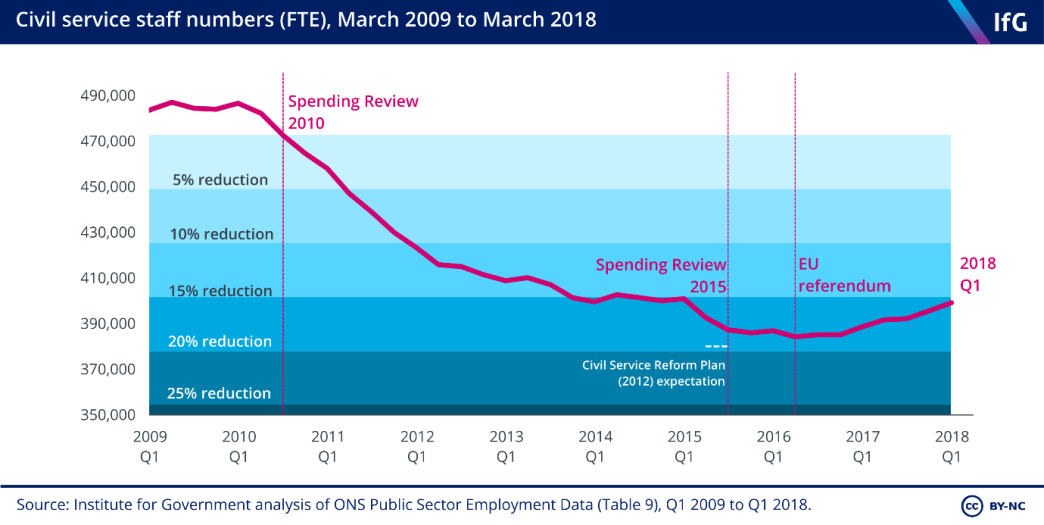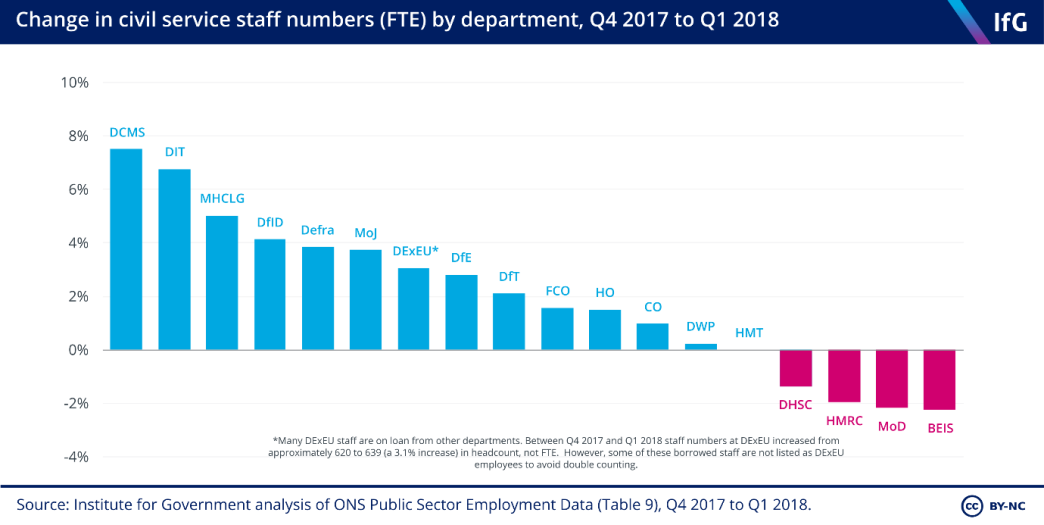Government plugs gaps in prison service staff
New civil service staff numbers show increases at the Prison and Probation Service, and spending on Brexit staff continuing to grow.
New civil service staff numbers show increases at the Prison and Probation Service, and spending on Brexit staff continuing to grow, says Gavin Freeguard.
There are now 399,080 civil servants, up 4% since the referendum with 14,820 jobs created. After continual cuts between the 2010 Spending Review and the referendum, the civil service has grown in each one of the seven quarters since. In effect, one in every six of the job cuts since 2010 has now been reversed – although it is still more than 15% smaller than at the 2010 Spending Review.

Government wakes up to impact of cuts
One of the most interesting rises came at the Ministry of Justice, where numbers are up by nearly 4%. Much of this is due to HM Prison and Probation Service recruiting nearly 2,000 staff between January and March 2018. This shows government trying to get to grips with public service pressures: as Performance Tracker has shown, the Government should have reacted much sooner to tackle rising problems in prisons, such as an increase in violent assaults. Instead, Chris Grayling concentrated on outsourcing probation and his successor as justice secretary, Michael Gove, committed to even more budget savings. Since Autumn 2016, the Government has woken up to the impact of reducing the number of prison officers and has started to recruit more.
The increase at the Department for Digital, Culture, Media and Sport (DCMS) – from 800 to 860, the largest percentage rise this quarter (7.5%) – also shows government trying to get to grips with new challenges. ‘Digital’ was added to the department’s name in 2017 to reflect its growing remit around digital policy and the digital economy. These numbers don’t include staff working on data policy transferred from the Cabinet Office in April.
Staff numbers have risen at some departments most directly affected by Brexit:
- The Department for International Trade (DIT) grew by 90 staff to 1,420 (a 6.8% increase, more than any department other than DCMS).
- DExEU now has 639 civil servants (excluding those on loan from other departments), up by 3%, a smaller rise than in previous quarters.
- The Department for Environment, Food and Rural Affairs (Defra), 80% of whose work is framed by EU legislation, is up 4%. Having had its staff cut by more than a third between the 2010 Spending Review and the EU referendum, it has added staff in every quarter since.
- The Home Office recorded a small rise of 1.5%, with rises in every quarter since the end of 2016. Those steady rises mean that it now employs 1,470 more staff than at the referendum – having said it would need to hire 1,500 extra staff to deal with Brexit by September 2018.

Numbers at the Department for Business, Energy and Industrial Strategy – the department with more Brexit work areas than any other – are down by around 2%. This might be because the department is still restructuring after its creation in July 2016, and BEIS has previously admitted it had a problem with staff turnover and put a contract out for tender to understand why.
Staff numbers at HM Revenue and Customs are also down by nearly 2%. This doesn’t mean HMRC, which has said it needs to hire between 3,000 and 5,000 more staff before March 2019, isn’t hiring for Brexit: it is one of the largest departments and staff reductions elsewhere, as it digitises parts of its operations, might be obscuring the effect of Brexit hires.
Additional analysis by James Taylor.
- Topic
- Civil service Public services
- Keywords
- Civil servants Criminal justice
- Publisher
- Institute for Government